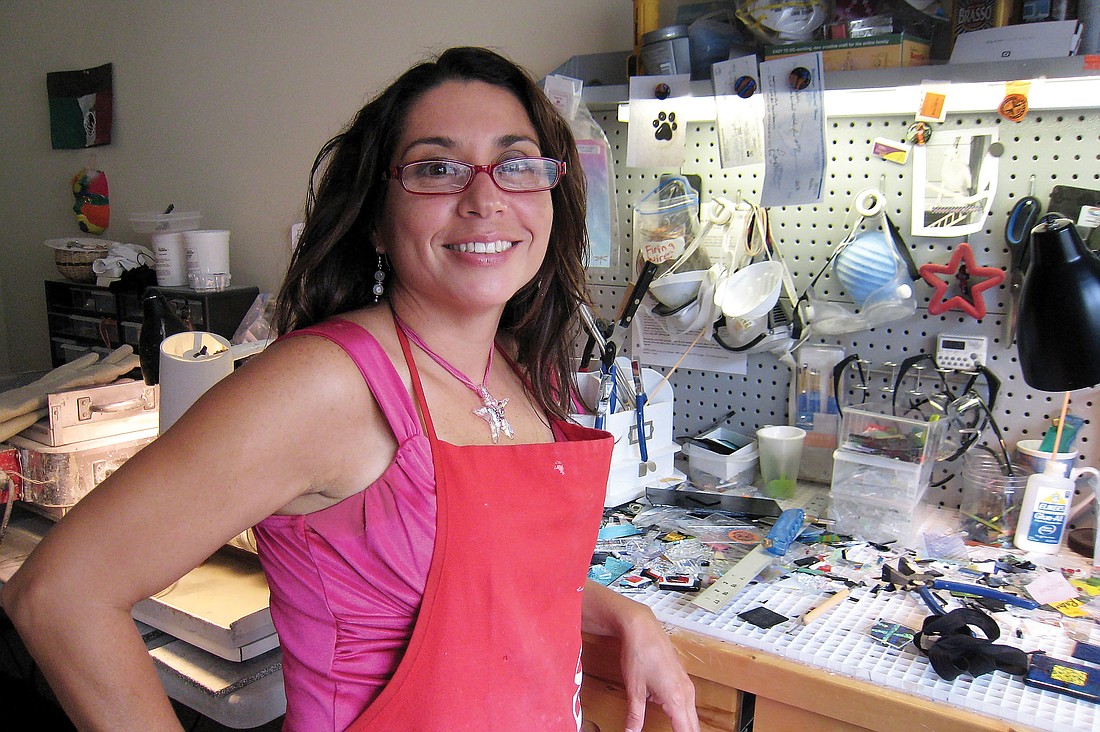- April 23, 2024
-
-
Loading

Loading

LAKEWOOD RANCH —The funeral home sends Silvia Engel a vial filled with a quarter teaspoon of ashes attached with an order form.
Inside her home art studio in the Central Park neighborhood of Lakewood Ranch, Engel fills the custom order.
One of three kilns, heated to 1,325 degrees, will fire the dark powdery remains into colorful glass art.
Engel works during the brightest part of the day. She wears a pink apron and listens to pop music while she works — a reflection of the “magical process” of memorializing loved ones through jewelry.
Clipped to the wall, a photograph — this one of a bird — reminds Engel whom she will be memorializing.
Engel, a Veracruz, Mexico, native, crafts made-to-order cremation jewelry for people who have lost loved ones — family members, friends, pets and even a Kentucky Derby race horse.
The process is Engel’s full-time business, called Love Ashes.
She started the business in 2007 when she lived in Iowa, after her dog, Kiki, died.
Engel, always artsy, especially in non-oil paints, ceramics and pottery, Googled, “How to memorialize your dog.”
She learned about dichroic glass, which NASA used in satellite mirrors.
She learned the glass has unique reflective and refractive properties, because of thin layers of metal oxides sprayed onto it — its color changes depending on how you tilt it.
Engel cremated Kiki and now wears her dog’s ashes in the form of a necklace.
Crafting with Kiki’s ashes felt normal. But the ide of handling ashes of people and creatures she didn’t know, and hearing stories from grieving customers, felt strange.
But, then, a friend called, with a story and a bag of cat ashes.
Soon, others called.
Engel learned to keep the calls short. Tearful phone calls made it difficult to focus on the job.
An elderly woman called to say she had lost four dogs in a house fire. Engel could soon describe the dog’s personalities in detail.
Engel transformed the dogs’ ashes into one rainbow-colored piece, but not before she learned a lesson.
“It’s cool to hear their stories,” Engel said, “but, then, I attach myself to them. I began to see it as a business. Dealing with death and handling ashes does not bother me. I learned to separate the personal part of it from what I do.”
Engel traveled to National Funeral Director Association conferences, 10 of them in as many years, to create relationships with soon-to-be partners.
She pitched the jewelry alongside people selling caskets.
“Funerals and death always scared me,” Engel said. “At first, I was like, ‘What am I doing here?’”
Today, most of Engel’s business comes from partnering with funeral homes.
A person will give the funeral home director a specifically prescribed amount of ashes along with a form detailing the type of jewelry they want — rings, earrings, pendants.
“If they want a Green Bay Packer design, I will give them that,” Engel said. “If they want a jellyfish design, I will give them that. Whatever makes them happy.”
The funeral home director sends the ashes and the order to Engel. She also partners with veterinarians and flower shops.
Other people send an order — and ashes — directly to Engel.
It took Engel eight months to develop the artistic process she uses today — an assembly line so efficient she can make 15 pieces at a time.
On this day, Engel completes an order from a funeral home in Columbia, Tenn.
The order is unique. It doesn’t call for jewelry at all. Engel has been assigned to create a dark-red-and-gold frame with “Dad” printed on it, along with his date of birth and death.
First, Engel measures and cuts the base of the piece, a nearly 3-inch piece of shiny black fusible glass — not reflective, like the dichroic glass.
She then slices four small squares of black cherry dichroic glass. She grinds each piece on a spinning grinding machine, shaving off excess glass to make a perfect square.
Engel glues each piece onto the black base and will wait three to four days for it to dry.
When they dry, she pours ashes onto another black piece of glass. She spreads the ashes out using a sharp dentist tool.
The ashes can either be visible (it looks like sand when it’s finished) or rest inside the piece, depending on the customer’s preference.
Engel sandwiches the black glass with the ashes onto her base with four tiles.
She covers the entire piece with a larger silver-blue radium glass, which will help the frame melt together.
She places the completed frame in the oven and leaves it there for 12 hours.
The entire process takes two to three weeks.
When it’s finished, Engel mails the excess ashes — many send more than required — back to the owner.
She will likely receive a thank-you card, which she will hang next to the photo of the bird.
Then, the cycle begins again.
“I feel their pain,” Engel said. “I know what they’re going through. But I have to keep professional, just like the funeral directors do.”
Contact Josh Siegel at [email protected].